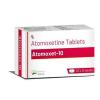Item(s): 0
Total: [ 0.00 GBP | 0.0000000 BTC ]



Methylphenidate is a central nervous system (CNS) stimulant. It is commonly used to treat attention deficit hyperactivity disorder (ADHD) and narcolepsy.
Adderall IR 30 mg: Uses, Side Effects, and Safety Information
Uses:
Adderall is used in the treatment of attention-deficit hyperactivity disorder (ADHD) and narcolepsy. It belongs to the drug class central nervous system (CNS) stimulants. Use during pregnancy is not recommended, as risk cannot be ruled out. Adderall IR 30 mg is classified as a Schedule II controlled substance under the Controlled Substances Act.
Common Side Effects:
Common side effects of Adderall IR include:
- Headache
- Insomnia
- Weight loss
- Anorexia
- Dry mouth (xerostomia)
- Nausea
- Emotional lability
(See below for a more comprehensive list of adverse effects.)
Formulations Covered:
Applies to amphetamine/dextroamphetamine: oral extended-release capsules and oral tablets.
Potential Side Effects:
While Adderall is effective for many individuals, it may also cause unwanted side effects, some of which may require medical attention.
Major Side Effects
Contact your doctor immediately if you experience any of the following:
More common:
- Bladder pain
- Bloody or cloudy urine
- Painful, burning, or difficult urination
- Fast, pounding, or irregular heartbeat
- Frequent urge to urinate
- Lower back or side pain
Less common:
- Cold or flu-like symptoms
- Cough or hoarseness
- Fever or chills
Incidence not known:
- Blistering, peeling, or loosening of the skin
- Chest pain or discomfort
- Confusion
- Convulsions
- Dark-colored urine
- Diarrhea
- Difficulty breathing, swallowing, or speaking
- Dizziness or fainting
- Double vision
- Headache
- Inability to move arms, legs, or facial muscles
- Itching
- Joint or muscle pain
- Large, hive-like swelling (face, lips, throat, hands, etc.)
- Loss of bladder control
- Muscle cramps, spasms, or stiffness
- Nausea or vomiting
- Pain in the arms, jaw, back, or neck
- Red skin lesions (often with a purple center)
- Red or irritated eyes
- Hallucinations (seeing, hearing, or feeling things that are not there)
- Skin rash
- Slow or slurred speech
- Sore throat or mouth sores
- Sudden loss of consciousness
- Excessive sweating
- Swelling of the feet or lower legs
- Chest tightness
- Tics or vocal outbursts
- Unusual tiredness or weakness
Minor Side Effects
These side effects typically do not require medical attention and may subside as your body adjusts to the medication. Consult your healthcare provider if they persist or become bothersome:
More common:
- Anxiety
- Dry mouth
- Fatigue or loss of strength
- Stomach pain
- Weight loss
Incidence not known:
- Constipation
- Decreased sexual desire or performance
- Euphoria or false sense of well-being
- Erectile dysfunction
- Involuntary movements (e.g., facial twitching, limb spasms)
Dosing Considerations
For All Patients:
Dosage should be individualized based on patient needs and response.
Adults with ADHD:
For patients starting treatment or switching from another medication, the recommended starting dose is 20 mg/day.
Children and Adolescents:
Dosing varies depending on age, condition severity, and response. A healthcare provider should determine the appropriate dose.

ADHD stands for Attention Deficit Hyperactivity Disorder.
It is a neurodevelopmental disorder that affects both children and adults, and is characterized by symptoms of inattention, hyperactivity, and impulsivity.
People with ADHD may have difficulty with organization, time management, completing tasks, and may struggle in academic, occupational or social settings.
There are various treatments available, including medication, therapy, and lifestyle changes, which can help individuals with ADHD manage their symptoms and improve their quality of life.







